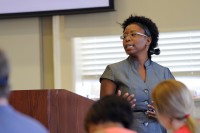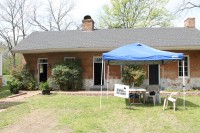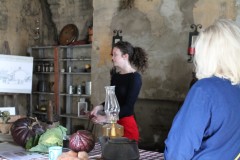Professor and Students Participate in Program Examining Slave Dwellings

This article, by Dr. Jodi Skipper, originally appeared in the Spring 2014 issue of the Southern Register. Check out our archive of past Registers for more.
Interpreting the Enslaved: The Behind the Big House Program in Holly Springs, Mississippi
For the past two years, Southern Studies students have helped to fill gaps in Mississippi interpretations of African American history by participating in the Behind the Big House (BTBH) program in Holly Springs, Mississippi. The program interprets the lives of the enslaved through extant former slave dwellings hidden in plain view. The dwellings were readapted for various uses—making it difficult to recognize their original purposes—and suppressed from historical memory, either unintentionally or by design.
 Several private property owners, including Chelius Carter, Jenifer Eggleston, David Person, and Genevieve and Frank Busby, initiated the project. According to Eggleston, “It was clear that a significant part of the historic narrative was missing. While a number of the silent witnesses—the structures directly related to the slaves’ accommodations—were extant, the stories of the people who lived and used these buildings was largely being forgotten.” The BTBHprogram seeks to remedy these omissions. Since 2012 the program has been a supplement to the yearly Holly Springs Pilgrimage (sponsored by the Garden Club), which has, for over 80 years, historically interpreted the lives of plantation-owning families through historic main houses. BTBH is a distinct program, with 20 sites listed on the tour program. It is free and open to the public, with a select few properties interpreted each year.
Several private property owners, including Chelius Carter, Jenifer Eggleston, David Person, and Genevieve and Frank Busby, initiated the project. According to Eggleston, “It was clear that a significant part of the historic narrative was missing. While a number of the silent witnesses—the structures directly related to the slaves’ accommodations—were extant, the stories of the people who lived and used these buildings was largely being forgotten.” The BTBHprogram seeks to remedy these omissions. Since 2012 the program has been a supplement to the yearly Holly Springs Pilgrimage (sponsored by the Garden Club), which has, for over 80 years, historically interpreted the lives of plantation-owning families through historic main houses. BTBH is a distinct program, with 20 sites listed on the tour program. It is free and open to the public, with a select few properties interpreted each year.

Eggleston and Carter, of Preserve Marshall County & Holly Springs, Inc., own the historic Hugh Craft House property, which includes a main house and former slave dwelling. A basement level in the slave dwelling included a room for smoking meat, a first level includes a kitchen and two separate living spaces, and a loft is a living space, likely sleeping quarters for enslaved children. Eggleston, a National Park Service grant writer, and Carter, an architectural historian, researched much of the historical information used for its interpretation, as well as interpretations for several other sites, including Burton Place; the Magnolias, the 1851 gothic revival home featured in the film Cookie’s Fortune (1999); and McCarroll Place, a former dwelling readapted as an antique store by one of its former owners. Joseph McGill Jr., former program officer with the National Trust for Historic Preservation and founder of the Slave Dwelling Project, offers additional interpretations. McGill, who has been spending nights in slave dwellings to bring attention to the need for their historic preservation, was brought in to help interpret sites.
I met McGill while working in South Carolina and became aware of the Holly Springs program after joining the faculty at the University of Mississippi. During the BTBH program’s second season I was teaching a course on Southern heritage tourism, and my thought process began to focus on how to organize students interested in the growing field of heritage tourism. In 2013 I chose the BTBH pilot program as a case study, and the class of five students made this applied approach feasible. Carter and Eggleston visited the class to discuss the development of the program. Students interviewed tourism officials in Holly Springs to get a better sense of the tourism political climate and each had the opportunity to work as a docent at more than one property.
I organized a lecture by McGill, held at Barnard Observatory, which was cosponsored by the Center for the Study of Southern Culture and the Department of Sociology and Anthropology. I also volunteered as a docent and joined Gracing the Table (GTT), a derivative of Coming to the Table, a national organization whose mission is to provide “leadership, resources, and a supportive environment for all who wish to acknowledge and heal wounds from racism that is rooted in the United States’ history of slavery.” GTT was organized as a response to members of the Holly Springs community’s realization that the interpretation of dwellings can become fruitless without the therapeutic work necessary to represent such issues. Through GTT, a group of diverse Holly Springs citizens meet once a month at a neutral location and interact through exercises prompting them to discuss slavery, race, and racism. It is largely a cooperative effort between private citizens and Rust College faculty and students . . . and now some Southern Studies graduate students.
In the program’s third season, first-year graduate student Lauren Holt joined the project. Holt is now a member of the GTT planning committee. This season she took charge of putting together the booklet that the BTBH program provided for local Holly Springs school groups coming through the tour. Working mainly from a guideline for program managers, BTBH information panels, and a high school textbook on Mississippi history, she put together a draft for the text. She also volunteered as a docent for four of the five program days, leading pilgrimage guests and local school groups. In all, some 450 students from Marshall and Benton county schools came through the program during a three-day period. Purvis Cornish, another first-year graduate student, led some of these school groups at the Hugh Craft House.
Since I began working with the BTBH, I have had several revelations. First, urban slavery has been historically underrepresented through historic preservation programs. Second, if places like Holly Springs are willing to tell more complex stories of their built environments, then it can be a benefit to all. And third, this work cannot be done without the support of institutions like the Mississippi Humanities Council, the Mississippi Development Authority/Tourism Division, local citizens, private landowners who value stories of the underprivileged, and volunteers who see the potentially restorative and reconciliatory value in local history. The BTBH program is a necessary one, yet it can only survive through the support of lovers of history everywhere.
